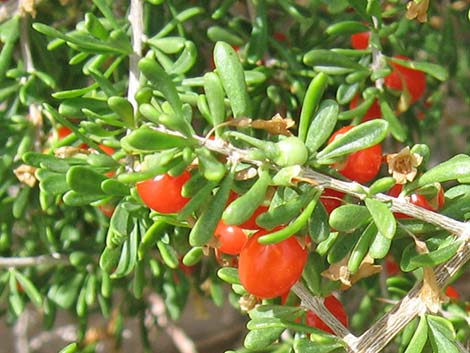
Wolfberry
Lycium andersonii
$6.99
Out of stock
Product Details
Anderson's Wolfberry (Lycium andersonii)
🪴 Pot Size: 4-Inch
Plant Description:
🌱 Introducing Anderson's Wolfberry, cultivated in a 4-inch pot. Scientifically known as Lycium andersonii, this deciduous shrub features slender green foliage and delicate, bell-shaped flowers, followed by small, red berries, making it a valuable addition to native landscapes and wildlife gardens.
Key Information:
🌞 Light: Flourishes in full sun to partial shade, adaptable to various light conditions.
💧 Watering: Requires well-draining soil and occasional deep waterings, particularly during hot, dry periods.
📏 Mature Size: Typically grows 2-4 feet tall and spreads 3-5 feet wide, forming a compact, spreading habit.
🌼 Flower Power: Produces clusters of small, lavender to purple flowers that give way to bright red berries, attracting pollinators such as bees and butterflies.
🌍 Growing Zones: Suitable for zones 5-9; Thrives in arid and semi-arid regions.
Flavor Profile:
Anderson's Wolfberry offers a mildly sweet and tart flavor, with a chewy texture when fresh or dried, making it a favorite food source for wildlife and birds.
Culinary Uses & Applications:
🍽️ Occasionally used in traditional Native American cuisine for its nutritional value
🥗 Provides food and habitat for wildlife, including birds, butterflies, and small mammals
🍃 Edible berries can be enjoyed fresh or dried, or used in jams, jellies, and sauces
Medicinal Uses & Applications:
Anderson's Wolfberry has a long history of use in traditional Native American medicine, valued for its potential health benefits and nutritional properties.
🌱 Growth Habits:
Anderson's Wolfberry forms dense, spreading shrubs with arching branches and abundant foliage, creating a naturalistic appearance in native landscapes and wildlife gardens.
🌿 Care:
Plant in well-draining soil amended with organic matter and provide supplemental waterings during periods of drought. Prune lightly to shape and encourage bushy growth.
🌍 Origin Stories and Historical Uses:
Native to western North America, Anderson's Wolfberry has been used for centuries by indigenous peoples for food, medicine, and ceremonial purposes. It plays a vital role in supporting local ecosystems and biodiversity.
⛔ Root Damage Potential:
Minimal root damage potential, making it suitable for planting in naturalistic landscapes and restoration projects.
⚠️ Safety Concerns:
Anderson's Wolfberry is generally safe for consumption by wildlife and humans. However, individuals with allergies to plants in the Solanaceae family (such as tomatoes and potatoes) should exercise caution. Enjoy the beauty and ecological benefits of Anderson's Wolfberry in your native garden or wildlife habitat!


